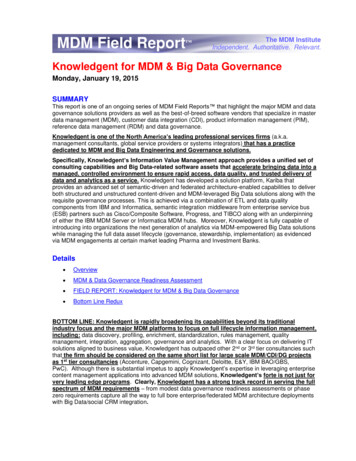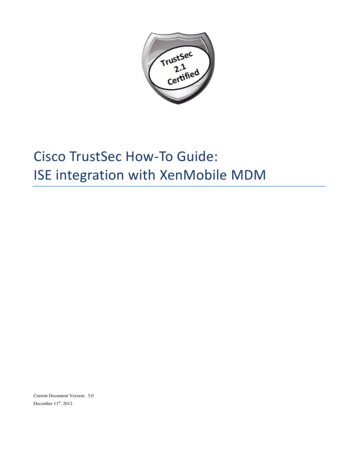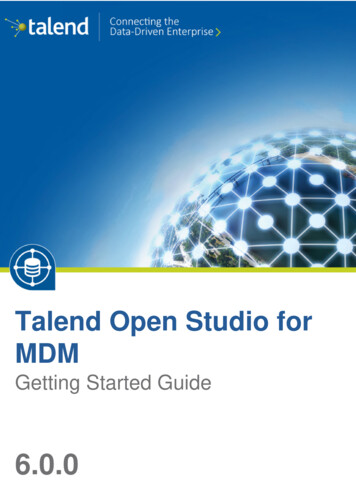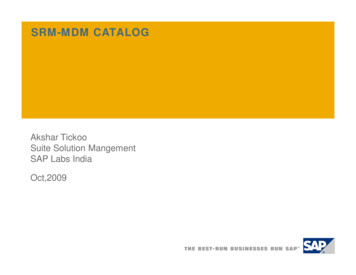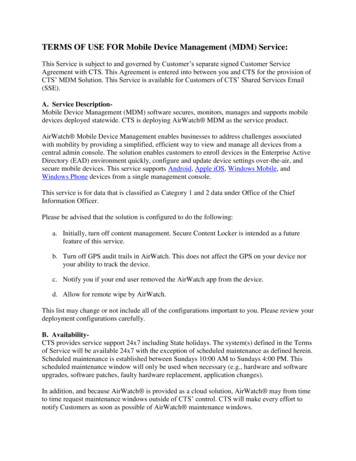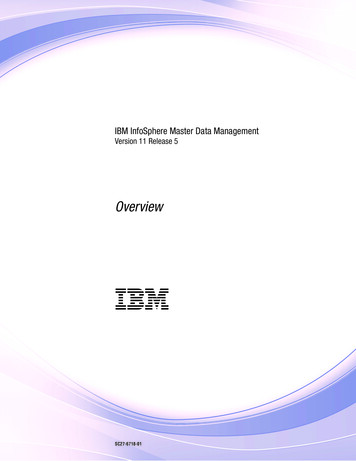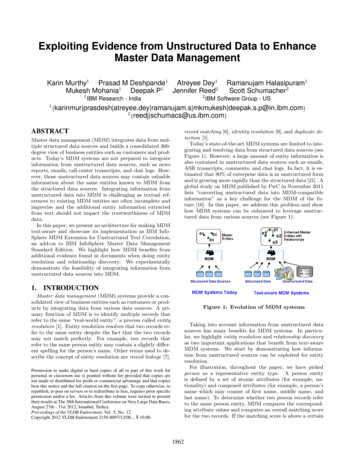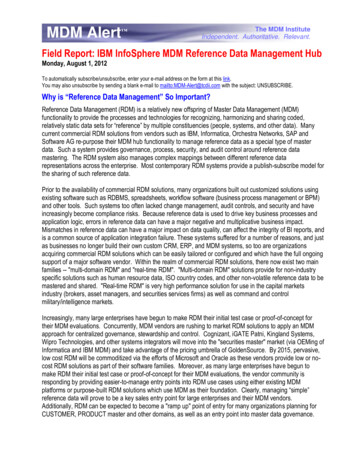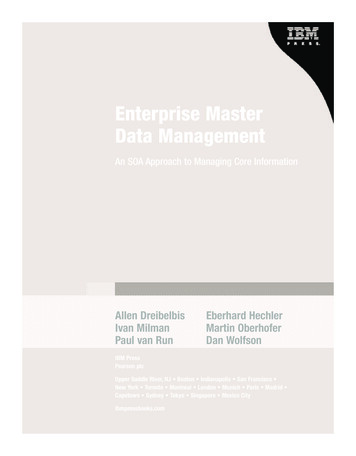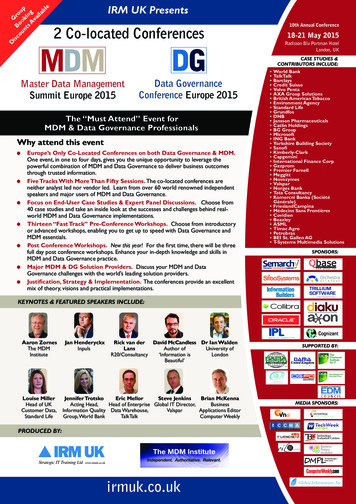
Transcription
D Base / Master Data Management and Customer Data Integration / Berson & Dubov / 226349-0 / Chapter 6CHAPTER6Data Management Concernsof MDM-CDI ArchitectureIN THIS CHAPTERData StrategyManaging Data in the Data Hub107ch06.indd 1074/26/07 2:25:49 PM
D Base / Master Data Management and Customer Data Integration / Berson & Dubov / 226349-0 / Chapter 6108Master Data Management and Customer Data IntegrationThe preceding chapters discussed the enterprise architecture framework asthe vehicle that helps resolve a multitude of complex and challenging issuesfacing MDM and CDI designers and implementers. As we focused on theCustomer Data Integration aspects of the MDM architecture, we showed how toapply the Enterprise Architecture Framework to the service-oriented view of theCDI platform, often called a Data Hub. And we also discussed a set of services thatany Data Hub platform should provide and/or support in order to deliver key dataintegration properties of matching and linking detail-level records—a service thatenables the creation and management of a complete view of the customers, theirassociations and relationships.We also started a discussion of the services required to ensure the integrity ofdata inside the Data Hub as well as services designed to enable synchronizationand reconciliation of data changes between the Data Hub and surrounding systems,applications, and data stores.We have now reached the point where the discussion of the Data Hub architecturecannot continue without considering issues and challenges of integrating a Data Hubplatform into the overall enterprise information environment. To accomplish thisintegration, we need to analyze the Data Hub architecture components and servicesthat support cross-systems and cross-domain information management requirements.These requirements include challenges of the enterprise data strategy, data governance,data quality, a broad suite of data management technologies, and the organizationalroles and responsibilities that enable effective integration and interoperability betweenthe Data Hub, its data sources, and its consumers (users and applications).An important clarification: as we continue to discuss key issues and concerns of theCDI architecture, services, and components, we focus on the logical and conceptualarchitecture points of view. That means that we express functional requirements ofCDI services and components in architecture terms. These component and servicerequirements should not be interpreted literally as the prescription for a specifictechnical implementation. Some of the concrete implementation approaches—designand product selection guidelines that are based on the currently available industry bestpractices and state of the art in the MDM and CDI product marketplace—are providedin Part IV of this book.Data StrategyThis chapter deals primarily with issues related to data management, data delivery,and data integration between a Data Hub system, its sources, and its consumers. Inorder to discuss the architecture concerns of data management we need to expandthe context of the enterprise architecture framework and its data managementdimensions by introducing key concerns and requirements of the enterprise datastrategy. While these concerns include data technology and architecture components,ch06.indd 1084/26/07 2:25:49 PM
D Base / Master Data Management and Customer Data Integration / Berson & Dubov / 226349-0 / Chapter 6Chapter 6: Data Management Concerns of MDM-CDI Architecture109the key insights of the enterprise data strategy are contained in its holistic andmultidimensional approach to the issues and concerns related to enterprise-classinformation management. Those readers already familiar with the concepts of datastrategy, data governance, and data stewardship can easily skip this section andproceed directly to the section titled “Managing Data in the Data Hub.”The multifaceted nature of the enterprise data strategy includes a number ofinterrelated disciplines such as data governance, data quality, data modeling,data management, data delivery, data synchronization and integrity, data securityand privacy, data availability, and many others. Clearly, any comprehensivediscussion of the enterprise data strategy that covers these disciplines is wellbeyond the scope of this book. However, in order to define and explain Data Hubrequirements to support enterprise-level integration with the existing and newapplications and systems, at a minimum we need to introduce several key conceptsbehind data governance, data quality, and data stewardship. Understanding theseconcepts helps explain the functional requirements of those Data Hub servicesand components that are designed to find the “right” data in the “right” data store,to measure and improve data quality, and to enable business-rules-driven datasynchronization between the Data Hub and other systems. We address the concernsof data security and privacy in Part III of this book, and additional implementationconcerns in Part IV.Data GovernanceLet’s consider the following working definition of data governance.Data GovernanceData governance is a process focused on managing the quality, consistency,usability, security, and availability of information. This process is closelylinked to the notions of data ownership and stewardship.Clearly, according to this definition, data governance becomes a critical componentof any Data Hub initiative. Indeed, an integrated CDI data architecture contains notonly the Data Hub but also many applications and databases that more often than notwere developed independently, in a typical stovepipe fashion, and the information theyuse is often inconsistent, incomplete, and of different quality.Data governance strategy helps deliver appropriate data to properly authorizedusers when they need it. Moreover, data governance and its data quality componentare responsible for creating data quality standards, data quality metrics, and dataquality measurement processes that together help deliver acceptable quality data tothe consumers—applications and end users.ch06.indd 1094/26/07 2:25:50 PM
D Base / Master Data Management and Customer Data Integration / Berson & Dubov / 226349-0 / Chapter 6110Master Data Management and Customer Data IntegrationData quality improvement and assurance are no longer optional activities. Forexample, the 2002 Sarbanes-Oxley Act requires, among other things, that a businessentity should be able to attest to the quality and accuracy of the data contained in theirfinancial statements. Obviously, the classical “garbage in—garbage out” expression isstill true, and no organization can report high-quality financial data if the source dataused to produce the financial numbers is of poor quality. To achieve compliance andto successfully implement an enterprise data governance and data quality strategy,the strategy itself should be treated as a value-added business proposition, and sold tothe organization’s stakeholders to obtain a management buy-in and commitment likeany other business case. The value of improved data quality is almost self-evident,and includes factors such as the enterprise’s ability to make better and more accuratedecisions, to gain deeper insights into the customer’s behavior, and to understand thecustomer’s propensity to buy products and services, the probability of the customer’sengaging in high-risk transactions, the probability of attrition, etc. The data governancestrategy is not limited to data quality and data management standards and policies. Itincludes critically important concerns of defining organizational structures and jobroles responsible for monitoring and enforcement of compliance with these policiesand standards throughout the organization.Committing an organization to implement a robust data governance strategyrequires an implementation plan that follows a well-defined and proven methodology.Although there are several effective data governance methodologies available, adetailed discussion of them is beyond the scope of this book. However, for the sakeof completeness, this section reviews key steps of a generic data governance strategyprogram as it may apply to the CDI Data Hub: ch06.indd 110Define a data governance process. This is the key in enabling monitoring andreconciliation of data between Data Hub and its sources and consumers. Thedata governance process should cover not only the initial data load but alsodata refinement, standardization, and aggregation activities along the path ofthe end-to-end information flow. The data governance process includes suchdata management and data quality concerns as the elimination of duplicateentries and creation of linking and matching keys. We showed in Chapter 5that these unique identifiers help aggregate or merge individual records intogroups or clusters based on certain criteria, for example, a household affiliationor a business entity. As the Data Hub is integrated into the overall enterprisedata management environment, the data governance process should definethe mechanisms that create and maintain valid cross-reference information inthe form of Record Locator metadata that enables linkages between the DataHub and other systems. In addition, a data governance process should containa component that supports manual corrections of false positive and negativematches as well as the exception processing of errors that cannot be handledautomatically.4/26/07 2:25:50 PM
D Base / Master Data Management and Customer Data Integration / Berson & Dubov / 226349-0 / Chapter 6Chapter 6: Data Management Concerns of MDM-CDI Architecture Design, select, and implement a data management and data deliverytechnology suite. In the case of a CDI Data Hub both data management anddata delivery technologies play a key role in enabling a fully integrated CDIsolution regardless of the architecture style of the Data Hub, be it a Registry,a Reconciliation Engine, or a Transaction Hub. Later in this chapter we willuse the principles and advantages of service-oriented architecture (SOA)to discuss the data management and data delivery aspects of the Data Hubarchitecture and the related data governance strategy. Enable auditability and accountability for all data under management thatis in scope for data governance strategy. Auditability is extremely importantas it not only provides verifiable records of the data access activities, but alsoserves as an invaluable tool to help achieve compliance with the current andemerging regulations including the Gramm-Leach-Bliley Act and its dataprotection clause, the Sarbanes-Oxley Act, and the Basel II Capital Accord.Auditability works hand in hand with accountability of data management anddata delivery actions. Accountability requires the creation and empowermentof several data governance roles within the organization including data ownersand data stewards. These roles should be created at appropriate levels of theorganization and assigned to the dedicated organizational units or individuals.111To complete this discussion, let’s briefly look at the concept of data stewards andtheir role in assessing, improving, and managing data quality.Data Stewardship and OwnershipAs the name implies, data owners are those individuals or groups within the organizationthat are in the position to obtain, create, and have significant control over the content(and sometimes, access to and the distribution of) the data. Data owners often belong toa business rather than a technology organization. For example, an insurance agent maybe the owner of the list of contacts of his or her clients and prospects.The concept of data stewardship is different from data ownership. Data stewardsdo not own the data and do not have complete control over its use. Their role is toensure that adequate, agreed-upon quality metrics are maintained on a continuousbasis. In order to be effective, data stewards should work with data architects,database administrators, ETL (Extract-Transform-Load) designers, businessintelligence and reporting application architects, and business data owners to defineand apply data quality metrics. These cross-functional teams are responsible foridentifying deficiencies in systems, applications, data stores, and processes thatcreate and change data and thus may introduce or create data quality problems. Oneconsequence of having a robust data stewardship program is its ability to help themembers of the IT organization to enhance appropriate architecture components toimprove data quality.ch06.indd 1114/26/07 2:25:50 PM
D Base / Master Data Management and Customer Data Integration / Berson & Dubov / 226349-0 / Chapter 6112Master Data Management and Customer Data IntegrationData stewards must help create and actively participate in processes thatwould allow the establishment of business-context-defined, measurable dataquality goals. Only after an organization has defined and agreed with the dataquality goals can the data stewards devise appropriate data quality improvementprograms.These data quality goals and the improvement programs should be driven primarilyby business units, so it stands to reason that in order to gain full knowledge of thedata quality issues, their roots, and the business impact of these issues, a data stewardshould be a member of a business team. Regardless of whether a data steward worksfor a business team or acts as a “virtual” member of the team, a data steward has to bevery closely aligned with the information technology group in order to discover andmitigate the risks introduced by inadequate data quality.Extending this logic even further, we can say that a data steward would be mosteffective if he or she can operate as close to the point of data acquisition as technicallypossible. For example, a steward for customer contact and service complaint data thatis created in a company’s service center may be most effective when operating insidethat service center.Finally, and in accordance with data governance principles, data stewards have tobe accountable for improving the data quality of the information domain they oversee.This means not only appropriate levels of empowerment but also the organization’swillingness and commitment to make the data steward’s data quality responsibilityhis or her primary job function, so that data quality improvement is recognized as animportant business function required to treat data as a valuable corporate asset.Data QualityData QualityData quality is one of the key components of any successful data strategyand data governance initiative, and is one of the core enabling requirementsfor Master Data Management and Customer Data Integration.Indeed, creating a new system of record from information of low quality isalmost an impossible task. Similarly, when data quality is poor, matching andlinking records for potential aggregation will most likely result in low matchaccuracy and produce an unacceptable number of false negative and false positiveoutcomes.Valuable lessons about the importance of data quality are abundant, and dataquality concerns confronted data architects, application designers, and businessch06.indd 1124/26/07 2:25:51 PM
D Base / Master Data Management and Customer Data Integration / Berson & Dubov / 226349-0 / Chapter 6Chapter 6: Data Management Concerns of MDM-CDI Architecture113users even before the problem started to manifest itself in the early data integrationprograms such as Customer Information Files (CIF), early implementations of datawarehouses (DW), Customer Relationship Management (CRM), and BusinessIntelligence (BI) solutions. Indeed, if you look at a data integration solution suchas a data warehouse, published statistics show that as high as 75 percent of thedata warehouse development effort is allocated to data preparation, validation, andextraction, transformation, and loading (ETL). Over 50 percent of these activities arespent on cleansing and standardizing the data.Although there is a wide variety of ETL and data cleansing tools that addresssome of the data quality problem, data quality continues to be a complex,enterprise-class challenge. Part of the complexity that needs to be addressed isdriven by the ever-increasing performance requirements. A data cleansing toolthat would take more than 24 hours to cleanse a customer file is a poor choicefor a real-time or a web-based customer service application. As the performanceand throughput requirements continue to increase, the functional and technicalcapabilities of the data quality tools are sometimes struggling to keep up withthe demand.But performance is not the primary issue. A key challenge of data quality isan incomplete or unclear set of semantic definitions of what the data is supposedto represent, in what form, with what kind of timeliness requirements, etc. Thesedefinitions are ideally stored in a metadata repository. Our experience shows thateven when an enterprise adapts a metadata strategy and implements a metadatarepository, its content often contains incomplete or erroneous (poor quality)definitions. We’ll discuss metadata issues in more details later in this chapter.The quality of metadata may be low not because organizations or data stewardsdo not work hard on defining it, but primarily because there are many dataquality dimensions and contexts, each of which may require a different approachto the measurement and improvement of the data quality. For example, if wewant to measure and improve address information about the customers, thereare numerous techniques and reference data sources that can provide an accurateview of a potentially misspelled or incomplete address. Similarly, if we need tovalidate a social security number or a driver license number, we can use a varietyof authoritative sources of this information to validate and correct the data. Theproblem becomes much harder when you deal with names or similar attributes forwhich there is no predefined domain or a business rule. For example, “Alec” maybe a valid name or a misspelled “Alex.” If evaluated independently, and not in thecontext of, say, postal information about a name and the address, this problem oftenrequires human intervention to resolve the uncertainty.Finally, as the sophistication of the data quality improvement process grows, sodo its cost and processing requirements. It is not unusual to hear that an organizationwould be reluctant to implement an expensive data quality improvement systemch06.indd 1134/26/07 2:25:51 PM
D Base / Master Data Management and Customer Data Integration / Berson & Dubov / 226349-0 / Chapter 6114Master Data Management and Customer Data Integrationbecause, according to them, “ so far the business and our customers do notcomplain, thus the data quality issue must not be as bad as you describe.” This is notan invalid argument, although it may be somewhat shortsighted from the strategicpoint of view, especially since many aspects of data quality fall under governmentand industry-regulated requirements.Data Quality Tools and TechnologiesThere are many tools that automate portions of the tasks associated with cleansing,extracting, loading, and auditing data from existing data stores into a new targetenvironment, be it a data warehouse or a CDI Data Hub. Most of these tools fall intoseveral major categories:ch06.indd 114 Auditing tools These tools enhance the accuracy and correctness of the dataat the source. These tools generally compare the data in the source databaseto a set of business rules that are either explicitly defined or automaticallyinferred from a scan operation of the data file or a database catalog. Auditingtools can determine the cardinality of certain data attributes, value rangesof the attributes in the data set, and the missing and incomplete data values,among other things. These tools would produce various data quality reportsand can use their output to automate certain data cleansing and data correctionoperations. Data cleansing tools These tools would employ various deterministic,probabilistic or machine learning techniques to correct the data problemsdiscovered by the auditing tools. These tools generally compare the data inthe data source to a set of business rules and domain constraints stored in themetadata repository or in an external rules repository. Traditionally, these toolswere designed to access external, reference data such as a valid name andaddress file from an external “trusted” data provider (e.g., Acxiom or Dun &Bradstreet), or an authoritative postal information file (e.g., National Changeof Address [NCOA] file), or to use a service that validates social securitynumbers. The data cleansing process improves the quality of the data andpotentially adds new, accurate content. Therefore, this process is sometimesreferred to as data enrichment. Data parsing and standardization tools The parsers would break arecord into atomic units that can be used in subsequent steps. For example,such a tool would parse one contiguous address record into separate street,city, state, and zip code fields. Data standardization tools convert the dataattributes to what is often called a canonical format or canonical datamodel—a standard format used by all components of the data acquisitionprocess and the target Data Hub.4/26/07 2:25:51 PM
D Base / Master Data Management and Customer Data Integration / Berson & Dubov / 226349-0 / Chapter 6Chapter 6: Data Management Concerns of MDM-CDI Architecture115Canonical Data FormatCanonical data format is a format that is independent of any specific application.It provides a level of abstraction from applications’ native data formats bysupporting a common format that can either be used by all applications or mayrequire transformation adapters that convert data between the canonical andnative formats. Adding a new application or a new data source may only requirea new adapter or modifying an old one, thus drastically reducing the impact onapplications. A canonical format is often encoded in XML. Data extraction, transformation, and loading (ETL) tools are not dataquality tools in the pure sense of the term. ETL tools are primarily designed toextract data from known structures of the source systems based on preparedand validated source data mapping, transforming input formats of the extractedfiles into a predefined target data store format (e.g., a Data Hub), and loadingthe transformed data into a target data environment, e.g., the Data Hub. SinceETL tools are aware of the target schema, they can prepare and load the datato preserve various integrity constraints including referential integrity andthe domain integrity constraints. They can filter out records that fail a datavalidity check, and usually produce exception reports used by data stewards toaddress data quality issues discovered at the load stage. This functionality helpsensure data quality and integrity of the target data store, which is the reason wementioned ETL tools in this section. Hybrid packages These packages may contain a complete set of ETLcomponents enriched by a data parser and a standardization engine, the dataaudit components, and the data cleansing components. These extract, parse,standardize, cleans, transform, and load processes are executed by a hybridpackage software in sequence and load consistently formatted and cleanseddata into the Data Hub.Managing Data in the Data HubArmed with the knowledge of the role of the enterprise data strategy, we candiscuss CDI Data Hub concerns that have to deal with acquiring, rationalizing,cleansing, transforming, and loading data into the Data Hub as well as the concernsof delivering the right data to the right consumer at the right time. In this chapter,ch06.indd 1154/26/07 2:25:52 PM
D Base / Master Data Management and Customer Data Integration / Berson & Dubov / 226349-0 / Chapter 6116Master Data Management and Customer Data Integrationwe also discuss interesting challenges and approaches of synchronizing data in theData Hub with applications and systems used to source the data in the first place.Let’s start with the already familiar Data Hub conceptual architecture that wefirst introduced in Chapter 5. This architecture shows the Data Hub data store andsupporting services in the larger context of the data management architecture (seeFigure 6-1). From the data strategy point of view, this architecture depicts datasources that feed the loading process, data access and data delivery interfaces,Extract-Transform-Load service layer, the Data Hub platform, and some genericconsuming applications.However, to better position our discussion of the data-related concerns, let’stransform our Data Hub conceptual architecture into a view that is specificallydesigned to emphasize data flows and operations related to managing data in andaround the Data Hub.Data Zone Architecture ApproachTo address data management concerns of the Data Hub environment, we introduce aconcept of the data zones and the supporting architectural components and services.The Data Zone architecture illustrated in Figure 6-2 employs sound architectureprinciples of the separation of concerns and loose coupling.Data sourcesInterfacesETLRules onciliationInternalsourceInternalsourceCustomer hub service platformWebserviceETLCustomer hubdata storeBatch/FTPAccountMgntBatch/FTPKeys and referencesData locatorCustomer dataviewsSecurity and visibilityInformation flowsFigure 6-1ch06.indd 116Conceptual Data Hub components and services architecture view4/26/07 2:26:00 PM
D Base / Master Data Management and Customer Data Integration / Berson & Dubov / 226349-0 / Chapter 6Chapter 6: Data Management Concerns of MDM-CDI Architecture117Consumer zoneThird Party data zoneReportinge.g., D&B,IMS, acxiomSourcesystems zoneETL zoneAppsHub rprise service bus for real time bi-directional synchronizationFigure 6-2Data Hub architecture—Data Zone viewSeparation of ConcernsIn software design, the principle of separation of concerns is linked tospecialization and cooperation: When designing a complex system, thefamiliar trade-off is between a few generic modules that can perform variousfunctions versus many specialized modules designed to work together in acooperative fashion. In complex systems, specialization of components helpsaddress the required functionality in a focused fashion, organizing groups ofconcerns into separate, designated, and specifically designed components.Turning to nature, consider the difference between simple and complexorganisms. Where simple organisms contain several generic cells that performall life-sustaining functions, a complex organism (e.g., an animal) is “built” froma number of specialized “components” such as heart, lungs, eyes, etc. Each ofthese components performs its functions in a cooperative fashion together withother components of the body. In other words, when the complexity is low tomoderate, having a few generic components simplifies the overall design. But, as thecomplexity of the system grows, the specialization of components helps address therequired functionality in a focused fashion, by organizing groups of concerns intoseparate specifically designed components.ch06.indd 1174/26/07 2:26:07 PM
D Base / Master Data Management and Customer Data Integration / Berson & Dubov / 226349-0 / Chapter 6118Master Data Management and Customer Data IntegrationWe briefly discussed the principle of Loose Coupling in the previous chapter whenwe looked at service-oriented architectures.Loose CouplingIn software design, loose coupling refers to the design approach that avoidsrigid, tightly coupled structures where changes to one component force thatchange to propagate throughout the systems, and where a failure or a poorperformance of one component may bring the entire system down.When we apply these architecture principles to the data architecture view of theData Hub, we can clearly delineate several functional domains, which we call zones.The Data Zones shown in Figure 6-2 include the following: Source Systems zone Third-Party Data Provider zone ETL/Acquisition zone Hub Services zone Information Consumer zone Enterprise Service Bus zoneTo make it very clear, this zone structure is a logical design construct that shouldbe used as a guide to help solve the complexity of data management issues. TheZone Architecture approach allows architects to consider complex data managementissues in the context of the overall enterprise data architecture. As a design guide, itdoes not mean that a Data Hub implementation has to include every zone and everycomponent. A specific CDI implementation may include a small subset of the datazones and their respective processes and components.Let’s review the key concerns addressed by the data zones shown in Figure 6-2. ch06.indd 118The Source Systems zone is the province of existing data sources, and theconcerns of managing these sources include good procedural understandingof data structures, content, timeliness, update periodicity, and such operationalconcerns as platform support, data availability, data access interfaces, accessmethods to the data sources, batch window processing requirements, etc. Inaddition to the source data, this zone contains enterprise reference data, such ascode tables used by an organization to provide product-name-to-product-codemapping, state code tables, branch numbers, account type reference tables, etc.4/26/07 2:26:07 PM
D Base / Master Data Management and Customer Data Integration / Berson & Dubov / 226349-0 / Chapter 6Chapter 6: Data Management Concerns of MDM-CDI Architecture119This zone contains “raw material” that is loaded into the Data Hub and usesinformation stored in the metadata repository to determine data attributes,formats, source sy
Chapter 6: Data Management Concerns of MDM-CDI Architecture 109 the key insights of the enterprise data strategy are contained in its holistic and multidimensional approach to the issues and concerns related to enterprise-class information management. Those readers already familiar with the concepts of data
